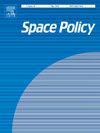Preliminary investigation and proposal of periodic orbits and their utilization for logistics in the cislunar regime
IF 1.9
4区 社会学
Q2 INTERNATIONAL RELATIONS
引用次数: 0
Abstract
The world is in the midst of what is widely considered the second Space Age due to the vastly growing commercial space sector and progress with international initiatives such as the Artemis program, led by the National Aeronautics and Space Administration (NASA). Cislunar space is becoming a region of growing interest as nations, international organizations, and private corporations look to expand their presence and outreach. The planned development of space infrastructure, such as lunar habitats, mining operations, and other installations, is driving the need for studies regarding common orbital pathways to ensure logistical support for future cislunar missions. Along with common orbital pathways, comprehensive and internationally acknowledged space policy and doctrine is required to ensure the safety, stability, and peace of this new frontier of human endeavor. This study serves to address one of the mission sets that will come to shape the emerging economy of the wider Earth-Moon system, space logistics. Specifically, this study will discuss potential orbits for a cislunar space situational awareness network that would support a space traffic management service, along with three cislunar logistics missions: personnel and cargo transport, space tourism, and search and rescue. Characteristics considered for orbits include orbit stability, period, and the proximity to key nodes in cislunar space such as the Moon and Lagrange points. Using Circular Restricted Three-Body Problem (CR3BP) dynamics, fourteen sample cislunar periodic orbits are proposed to accomplish the cislunar missions discussed. This study adds to the limited work in the field of cislunar orbital design to generate novel orbits and apply them to logistical use cases. All missions, except tourism, feature a “touring” class of cislunar periodic orbits due to their unique geometries enabling them to traverse a wide range of cislunar space. Preliminary analysis indicates that all of the proposed orbits are classified as marginally unstable, and suggests that minimal propellant is required to maintain a space vehicle's intended cislunar trajectory. Finally, existing law, policy, and governance surrounding cislunar space logistics and operations is discussed specifically concerning space traffic management, transportation, and humans touring or being rescued from space. Special attention is given to both the ambiguity of the law and the limitations of current norms of behavior, patent and property concerns, and tense geopolitical situations that can further complicate peace. Overall, this study highlights the underdevelopment of current space law and policy with the ambiguity of present-day norms discussed.
周期轨道的初步调查和建议及其在顺星轨道物流中的应用
世界正处于被广泛认为是第二个太空时代的中间,由于商业太空部门的巨大增长和国际倡议的进展,如由美国国家航空航天局(NASA)领导的阿尔忒弥斯计划。随着各国、国际组织和私营公司寻求扩大其存在和服务范围,地月空间正成为人们越来越感兴趣的领域。太空基础设施的规划发展,如月球栖息地、采矿作业和其他设施,正在推动对共同轨道路径的研究,以确保未来地月任务的后勤支持。除了共同的轨道路径外,还需要全面和国际公认的空间政策和理论,以确保这一人类努力的新领域的安全、稳定与和平。这项研究旨在解决一个任务集,它将塑造更广泛的地月系统的新兴经济,即空间物流。具体来说,该研究将讨论地月空间态势感知网络的潜在轨道,该网络将支持空间交通管理服务,以及三个地月后勤任务:人员和货物运输、空间旅游和搜索与救援。考虑轨道的特征包括轨道稳定性、周期以及与月球和拉格朗日点等地月空间关键节点的接近程度。利用圆形受限三体问题(CR3BP)动力学,提出了14个样本地月周期轨道来完成所讨论的地月任务。这项研究增加了在地月轨道设计领域的有限工作,以产生新的轨道并将其应用于后勤用例。除了旅游之外,所有的任务都以“旅行”类的地月周期轨道为特色,因为它们独特的几何形状使它们能够穿越大范围的地月空间。初步分析表明,所有提议的轨道都被归类为略微不稳定的轨道,并表明,维持太空飞行器预定的顺月轨道所需的推进剂最少。最后,讨论了围绕地月空间物流和运营的现有法律、政策和治理,具体涉及空间交通管理、运输和人类在太空旅行或从太空获救。特别注意到法律的模糊性和现行行为规范的局限性、专利和财产问题以及可能使和平进一步复杂化的紧张的地缘政治局势。总的来说,这项研究突出了当前空间法律和政策的不发达,并讨论了当前规范的模糊性。
本文章由计算机程序翻译,如有差异,请以英文原文为准。
求助全文
约1分钟内获得全文
求助全文
来源期刊

Space Policy
Multiple-
CiteScore
3.40
自引率
36.40%
发文量
40
期刊介绍:
Space Policy is an international, interdisciplinary journal which draws on the fields of international relations, economics, history, aerospace studies, security studies, development studies, political science and ethics to provide discussion and analysis of space activities in their political, economic, industrial, legal, cultural and social contexts. Alongside full-length papers, which are subject to a double-blind peer review system, the journal publishes opinion pieces, case studies and short reports and, in so doing, it aims to provide a forum for the exchange of ideas and opinions and a means by which authors can alert policy makers and international organizations to their views. Space Policy is also a journal of record, reproducing, in whole or part, official documents such as treaties, space agency plans or government reports relevant to the space community. Views expressed in the journal are not necessarily those of the editors or members of the editorial board.
 求助内容:
求助内容: 应助结果提醒方式:
应助结果提醒方式:


